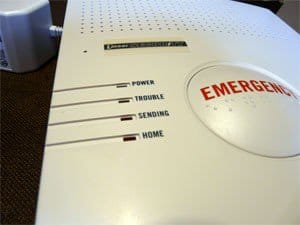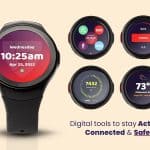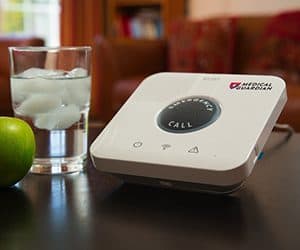
Traditional Medical Alert Systems
Here are some examples of typical medical monitoring devices that you may find while searching for the right medical alert company These models provide the two-way voice feature, made popular in the industry by Life Alert systems, with the phrase “I’ve fallen and I can’t get up.”
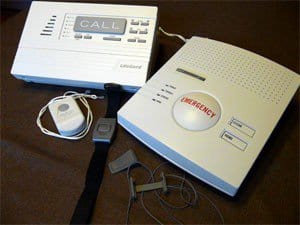
The main components of the emergency response system are the console and the medical alert button that can be usually worn on a belt, as a necklace or as a wristband.
Let’s take a look at the main features that these systems provide. We will focus on the popular Linear Personal Emergency Reporting System, that is used by many providers, including LifeStation and Lifefone. Read our Lifeline reviews for even more information.
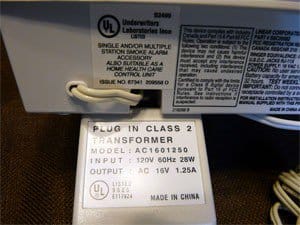
Medical Alert Equipment Certification
This medical alert system is UL Listed as a home healthcare signaling device, which means that it has been tested and certified by one of the most respected independent testing agencies in the world. This is why we always suggest going with a company who has the UL certified equipment. You can find this information in the medical alert device reviews sections of our website.
Since these personal emergency response systems (PERS) are programmable, they may function differently than described here. Your medical alert service provider will pre-program your system to their standards and specifications to ensure that your system will work properly.
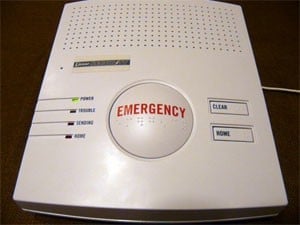
Base Unit Console
As you can see, the system console looks like a large answering machine with three buttons, that are molded with Braille characters for the visually impaired. The first and most obvious is the large round, Emergency button.
When this button is pressed and momentarily held, the console may announce “emergency,” make a tone sound through its speaker, or some other feature, depending on your provider. Its Sending light will flash while it’s sending your loved one’s account information to the monitoring center. Within moments, you will be connected to trained operators who will get you the help you need and notify your loved ones.
Base Station Power Light
There are two more lights on the unit. The first, is the power light which tells you the unit is getting power from your outlet.
The power light on the medical alert device base station also tells a few more important things:
- It will blink slowly when the back-up battery is charging.
- It will blink quickly when there is a power loss and your system is running on your back-up battery.
- The light is off when there is a power loss and your back-up battery has used all its available power
- It may also be off if it’s in test or set-up mode. You should never be in either, unless instructed by your medical alert company.
Call the your medical alert service provider immediately if you find the power light off, the unit plugged in, and the outlet your plugged into has power. This may indicate another problem with the unit.
Base Station Trouble Light
The final light on the base station is the Trouble light. If this light is off, then you know your system is operating properly with no issues.
- The light will turn on if any of your watch, pendant, or other buttons are missing or out of range for a predetermined time.
- If one of the buttons has a low battery, the trouble light will blink slowly. You must contact your service provider immediately if any of these trouble conditions exist.
You should be able to contact your provider 24 hours a day, 7 days a week if you have trouble.
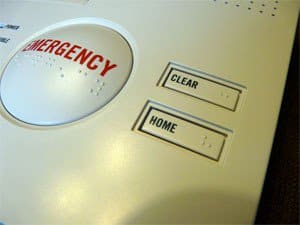
Additional Medical Alert Features
The last button on this medical alert system is the Home button. This button is used for Activity Monitoring. How this feature works is simple – you or your loved one must press the Home button once every 24 hours to let the system know that you are OK and not to send an “inactivity” alarm to the monitoring station.
You might be thinking, “I’m not going to remember to do that?” or “My mom is going to forget.” Don’t worry, the system will remember for you, using the Home light.
- The Home light will be on showing that the activity timer is running.
- The Home light will blink and a short beep tone will sound every ten seconds when less than 15 minutes remain before the system sends the inactivity alarm.
- Once the button is pressed, the timer will reset for another 24 hours.
This feature provides greater independence by letting caregivers know you are OK, every day. This is peace of mind that can be enjoyed by all!
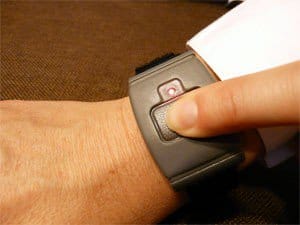
Medical Alert Button
When the portable wrist or other wall mounted device is pressed for at least two seconds, the same sequence of events, will occur. If your system has a clear or cancel button, that will usually stop the local sounder, if programmed, and send in “cancel” signal to the monitoring center. How the monitoring station will react to the cancel request is company specific and will be outlined in your instruction manual.
When the signal has been received and acknowledged, (this happens rather quickly), the unit will stop making any local noises, so the monitoring center representative and your loved one, can talk hands-free. This is one of the best features of these medical alarm systems. When you or your loved one can talk to the monitoring center operator, needed comfort and more personalized emergency service can be provided. Don’t get a system without two-way voice! Once you are connected to the trained operator, they will notify your circle of care and/or get emergency response out to you immediately.
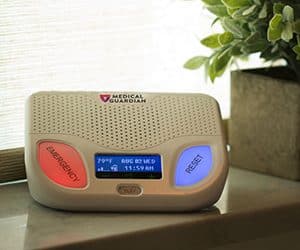
Cellular Based Medical Alert Systems
If your home does not have a traditional phone landline, you can take advantage of a wireless medical alert system. Keep in mind it might increase the life alert cost per month. The system works in the identical way as described above however, it is operated on the same cellular network as your mobile phone instead of through the landline. The alert button can be worn several ways, such as an alert bracelet or necklace. Once the button is pushed, the signal will be sent to the base unit wirelessly and then to the monitoring center via the mobile network. All cellular fees are included in your monthly costs paid to the medical alert company. This is a great option for those who do not want to carry the additional expense of a home landline!
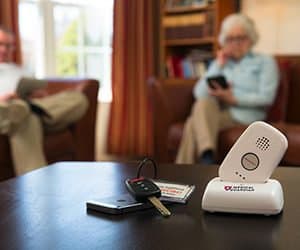
GPS Cellular Medical Alert Systems
Similar to how your cell phone can display a map of where you currently are or how a car navigation system works, some medical alert mobile alarms have an additional feature of GPS built-in to get you help when you’re away from your home. You can take it anywhere that has cellular phone coverage. This allows the flexibly of using the system outside of the home. Once you press the button, the central monitoring station can send help to your current location and some systems even allow two-way voice response through the device’s built-in speaker. The GPS signal will help send emergency response to your exact location so you can feel confident wherever you are.
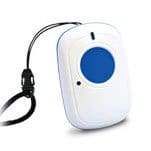
Fall Detection Systems
Some medical alert systems have automatic fall detection built into the medical alert pendant. The technology will be able to detect an actual fall from every day movement and if there is no response within a given time period, it will automatically send emergency response personnel to you. The sensors can detect a fall in as little as two feet however it can not detect a sliding motion, therefore it is not 100% accurate. It is however, an excellent addition to your medical alert monitoring plan if you feel you need this extra level of protection.
